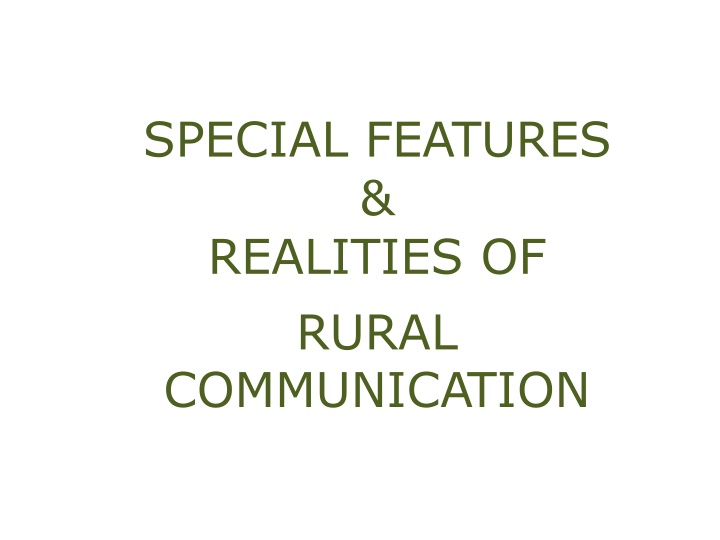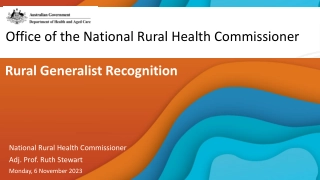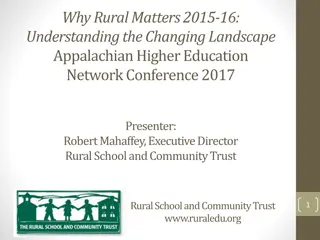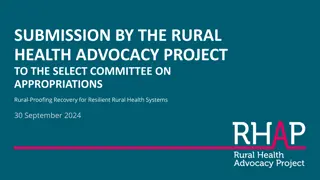Insights into Rural Communication and Community Life
Discover the special features, realities, and main characteristics of rural communication, rural areas, and rural communities. Explore the unique aspects of life in rural areas, such as limited services, agricultural focus, and strong community ties. Learn about the influence of nature, agriculture, and village institutions on the lives of rural people. Gain insights into rural development and the distinct lifestyle differences between rural and urban areas.
Download Presentation

Please find below an Image/Link to download the presentation.
The content on the website is provided AS IS for your information and personal use only. It may not be sold, licensed, or shared on other websites without obtaining consent from the author.If you encounter any issues during the download, it is possible that the publisher has removed the file from their server.
You are allowed to download the files provided on this website for personal or commercial use, subject to the condition that they are used lawfully. All files are the property of their respective owners.
The content on the website is provided AS IS for your information and personal use only. It may not be sold, licensed, or shared on other websites without obtaining consent from the author.
E N D
Presentation Transcript
SPECIAL FEATURES & REALITIES OF RURAL COMMUNICATION
RURAL AREA Where the people are engaged in primary industry in the sense that they produce things directly for cooperation with nature. the first time in
Rural areas are separately settled places away from the influence of large cities and towns. Such areas are distinct from more intensively settled urban and sub-urban areas, and also from unsettled lands or wilderness, such as forest. Rural areas can have an agricultural character, though many rural areas are characterized by an economy based on cottage industry, mining, oil and gas exploration, or tourism.
RURAL COMMUNITY A group of people with a common characteristic or interest living together, in a village. A Rural Community can be classified as rural based on the criteria of lower population density, less social differentiation, less social and spatial mobility, slow rate of social change, etc. Agriculture is the major occupation of rural people.
MAIN FEATURES OF RURALCOMMUNITY Village is an institution- The Village is a primary institution. The development of villages is influenced considerably by the life of the village. It satisfies almost all the needs of the rural. Community- They have a sense of unity and a feeling of belongingness towards each other. Religion- Faith in religion and universal power is found in the life of the villages. Agriculture- Main occupation is agriculture which involves dependence on nature. Nature gives the livelihood to them. Farmers worship forces of nature.
LIFE OF RURAL PEOPLE
Lifestyles in rural areas are different than those in urban areas, mainly because limited services are available. Governmental services like law enforcement, schools, fire departments, and libraries may be distant, limited in scope, or unavailable. Utilities like water, sewer, street lighting, and garbage collection may not be present. Public transport is sometimes absent or very limited, people use their own vehicles, walk or ride an animal.
RURAL DEVELOPMENT
As a concept, it connotes overall development of rural areas with a view to improve the quality of life rural people. As a discipline, it is multi-disciplinary in nature representing an intersection of agricultural, social, behavioural and management of sciences. In short, rural development is a process that aims at improving the standard of living of the people living in the rural areas.
The United Nations defines Rural Development as: Rural Development is a process of change, by which the efforts of the people themselves are authorities to improve their economic, conditions of communities in to the life of the nation and to enable them to contribute fully to national programme. united, those social of government and cultural Rural development can be defined as, helping rural people set the priorities in their own communities through effective and democratic bodies, by providing the local capacity; investment in basic infrastructure and social services, justice, equity and security, dealing with the injustices of the past and ensuring safety and security of the rural population, especially that of women.
DEV. IN RURAL AREA CAN BRING INFA- STRUCTURE TECHNO LOGY ECONOMY HEALTH EDUCATION
OBJECTIVES OF RURAL DEV. 1.To develop farm, home, public service and village community. 2. To bring improvement in producing of crops and animals living condition. 3.To improve health and education condition etc. improvement of the rural people. 4. To improve villagers with their own efforts. 5. To improve village communication.
Main Objectives To build Infrastructure Public Service Communication To improve Health Education Living condition To generate Economical activities Employment Farm & storage
PROBLEMS IN RURAL DEVELOPMENT 1.People related 2.Agricultural related problems 3.Infrastructure related problems 4.Economic problems 5.Social and Cultural problems 6.Leadership related problems 7.Administrative problems
PEOPLE RELATED PROBLEMS
1. Traditional way of thinking. 2. Poor understanding. 3.Low level of education to understand developmental efforts and new technology. 4. Deprived psychology and scientific orientation. 5. Lack of confidence. 6. Poor awareness. 7. Low level of education. 8. Existence of unfelt needs. 9. Personal ego.
AGRICULTURE RELATED PROB.
1. Lack of expected awareness, knowledge, skill and attitude. 2. Unavailability of inputs. 3. Poor marketing facility. 4. Insufficient extension staff and services. 5. Multidimensional tasks to extension personnel. 6. Small size of land holding. 7. Division of land. 8. Unwillingness to work and stay in rural areas.
INFASTRUCTRAL RELATED PROB. Poor infrastructure facilities like-: 1.Water 2.Electricity 3.Transport 4.Educational institutions 5.Communication 6.Health 7.Employment 8.Storage facility etc.
ECONOMIC PROBLEMS 1. Unfavourable economic condition to adopt high cost technology. 2. High cost of inputs. 3. Under privileged rural industries
LEADERSHIP RELATED PROBLEM 1.Leadership among the hands of inactive and incompetent people. 2. Self interest of leaders. 3. Biased political will
ADMINISTRATIVE PROBLEMS 1. Political interference. 2. Lack of motivation and interest. 3. Unwillingness to work in villages. 4. Improper utilization of budget. 5. No proper monitoring of program and lack in s. their implementation.
SCOPE & IMPORTANCE OF RURAL DEVELOPMENT
Importance of Rural Development Rural development is a dynamic process, which is mainly concerned with the rural areas. These include- Agricultural growth, putting up of economic and social infrastructure, fair wages as also housing and house sites for the landless, village planning, public health, education and functional literacy, communication etc. Rural development is a national necessity and has considerable importance in India
Rural development is needed because- : 1.To develop rural area as whole in terms of culture, society, economy, technology and health. 2. To develop living slandered of rural mass. 3. To develop rural youths, children and women. 4.To develop and empower human resource of rural area in terms of their psychology, skill, knowledge, attitude and other abilities. 5.To solve the problems faced by the rural mass for their development.
6. To develop infrastructure facility of rural area. 7.To provide minimum facility to rural mass in terms of drinking water, education, transport, electricity and communication. 8.To develop rural institutions like Panchayat, cooperatives, post, banking and credit. 9.To develop rural industries through the development of handicrafts, small scaled industries, village industries, rural crafts, cottage industries and other related economic operations in the rural sector. 10. To develop agriculture, animal husbandry and other agricultural related areas.
11.To restore uncultivated land, provide irrigation facilities and motivate farmers to adopt improved seed, fertilizers, package of practices of crop cultivation and soil conservation methods. 12.To develop entertainment and recreational facility for rural mass. 13. To develop leadership quality of rural area. 14. To improve rural marketing facility. 15. To minimise gap between the urban and rural in terms of facilities availed.
16.To improve rural peoples participation in the development of state and nation as whole. 17.To improve scopes of employment for rural mass. 18.For the sustainable development of rural area. 19. To eliminate rural poverty. 20. To empower them.























